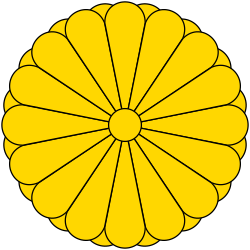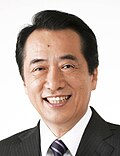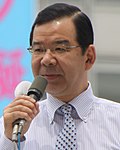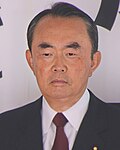| Northern Japan |
|---|
| Prefecture | Seats up | Incumbents | Party | Result | Candidates
(Party – endorsements)
Vote share |
|---|
| Hokkaidō | 2 | Yoshio Nakagawa | Sunrise | Incumbents retired
Democratic hold
Liberal Democratic pickup | Gaku Hasegawa (LDP) 34.3%
Eri Tokunaga (DPJ – PNP, NPD) 25.6%
Masahi Fujikawa (DPJ) 20.5%
Ken'ichi Nakagawa (YP) 11.6%
Kazuya Hatayama (JCP) 7.2%
Makoto Ōbayashi (HRP) 0.8% |
| Naoki Minezaki | Democratic |
| Aomori | 1 | Masami Tanabu | Democratic | Incumbent retired
Liberal Democratic pickup | Tsutomu Yamazaki (LDP) 46.8%
Rina Hatano (DPJ – PNP) 36.3%
Sekio Masuta (SPJ) 8.0%
Yō Yoshimata (JCP) 5.1%
Kiyohiko Yamada (SDP) 3.9% |
| Iwate | 1 | Ryō Shuhama | Democratic | Incumbent re-elected | Ryō Shuhama (DPJ – PNP) 54.2%
Yukifumi Takahashi (LDP) 30.4%
Masahiro Isawa (SDP) 8.5%
Sadakiyo Segawa (JCP) 6.9% |
| Miyagi | 2 | Ichirō Ichikawa | Liberal Democratic
(see note) | Liberal Democratic incumbent lost re-election
Democratic incumbent re-elected
Liberal Democratic hold | Yutaka Kumagai (LDP) 26.8%
Mitsuru Sakurai (DPJ – PNP) 24.4%
Hiromi Itō (DPJ – PNP) 16.5%
Ichirō Ichikawa (I) 11.0%
Fumihiro Kikuchi (YP) 10.8%
Tetsuo Kanno (SDP) 5.2%
Mikio Katō (JCP) 4.5%
Yoshiaki Murakami (HRP) 0.7% |
| Mitsuru Sakurai | Democratic |
| Akita | 1 | Yōetsu Suzuki | Democratic | Incumbent lost re-election
Liberal Democratic pickup | Hiroo Ishii (LDP) 55.6%
Yōetsu Suzuki (DPJ) 38.3%
Kazuhisa Fujita (JCP) 6.1% |
| Yamagata | 1 | Kōichi Kishi | Liberal Democratic | Incumbent re-elected | Kōichi Kishi (LDP) 43.6%
Yōsei Umetsu (DPJ) 36.8%
Hiroaki Kawano (YP) 14.6%
Toshio Ōta (JCP) 5.0% |
| Fukushima | 2 | Teruhiko Mashiko | Democratic | Incumbents re-elected | Teruhiko Mashiko (DPJ) 34.4%
Mitsuhide Iwaki (LDP) 34.1%
Mitsunori Okabe (DPJ) 15.6%
Kazumasa Sugamoto (YP) 9.4%
Tomo Iwabuchi (JCP) 6.5% |
| Mitsuhide Iwaki | Liberal Democratic |
| Eastern and Central Japan |
|---|
| Prefecture | Seats up | Incumbents | Party | Result | Candidates
(Party – endorsements)
Vote share |
|---|
| Ibaraki | 2 | Hiroshi Okada | Liberal Democratic | Incumbents re-elected | Hiroshi Okada (LDP) 38.7%
Akira Gunji (DPJ) 23.8%
Tomohiro Nagatsuka (DPJ) 15.9%
Shigenori Ōkawa (YP) 11.7%
Rie Yoshida (SPJ) 5.1%
Nobutoshi Inaba (JCP) 3.9%
Kōki Nakamura (HRP) 0.9% |
| Akira Gunji | Democratic |
| Tochigi | 1 | Susumu Yanase | Democratic | 1 seat lost by reapportionment
New Renaissance incumbent retired
Democratic incumbent lost re-election
Liberal Democratic pickup | Michiko Ueno (LDP) 36.2%
Susumu Yanase (DPJ – PNP) 35.6%
Daiju Araki (YP) 25.0%
Kazunori Koike (JCP) 3.2% |
| Tetsurō Yano | New Renaissance |
| Gunma | 1 | Yukio Tomioka | Democratic | 1 seat lost by reapportionment
Democratic incumbent lost re-election
Liberal Democratic incumbent re-elected | Hirofumi Nakasone (LDP) 60.6%
Yukio Tomioka (DPJ) 31.2%
Setsuko Takahashi (JCP) 8.2% |
| Hirofumi Nakasone | Liberal Democratic |
| Saitama | 3 | Chiyako Shimada | Democratic | Liberal Democratic and Justice incumbents re-elected
Democratic incumbent lost re-election
Democratic hold | Masakazu Sekiguchi (LDP) 20.6%
Makoto Nishida (Kōmei) 18.7%
Motohiro Ōno (DPJ) 17.5%
Chiyako Shimada (DPJ) 17.1%
Tsukasa Kobayashi (YP) 13.1%
Gaku Itō (JCP) 6.5%
Kōji Nakagawa (NRP) 2.7%
Fumihiro Himori (SDP) 2.3%
Kōsei Hasegawa (I) 1.2%
Hirotoshi Inda (HRP) 0.3% |
| Masakazu Sekiguchi | Liberal Democratic |
| Makoto Nishida | Justice |
| Chiba | 3 | Wakako Hironaka | Democratic | 1 seat gained by reapportionment
Democratic incumbent retired
Liberal Democratic incumbent lost re-election
Democratic and Liberal Democratic hold
Your pickup | Hiroyuki Konishi (LDP) 20.2%
Kuniko Inoguchi (DPJ) 19.3%
Ken'ichi Mizuno (YP) 17.9%
Ayumi Michi (DPJ) 17.4%
Kazuyasu Shiina (LDP) 14.9%
Kazuko Saitō (JCP) 6.2%
Hisashi Koga (NRP) 2.5%
Satoshi Shimizu (JIP) 1.1%
Masahiko Makino (HRP) 0.5% |
| Kazuyasu Shiina | Liberal Democratic |
| Tokyo | 5 | Masaharu Nakagawa | Liberal Democratic | 1 seat gained by reapportionment
Democratic and Liberal Democratic incumbents re-elected
Justice incumbent retired
Justice hold
Your pickup | Renhō (DPJ) 28.1%
Toshiko Takeya (Kōmei) 13.2%
Masaharu Nakagawa (LDP) 11.7%
Toshio Ogawa (DPJ) 11.4%
Kōta Matsuda (YP) 10.8%
Akira Koike (JCP) 9.1%
Yukiko Tōkai (LDP) 4.9%
Hiroshi Yamada (JIP) 3.3%
Asako Ogura (SPJ) 2.0%
Hideo Morihara (SDP) 1.6%
Kōtarō Umiji (NRP) 1.3%
Saori Egi (PNP) 0.9%
Yūmi Ishihara (I) 0.7%
Hiroko Tanaka (I) 0.3 %
Hisshō Yanai (HRP) 0.2%
9 other candidates 0.7% |
| Toshio Ogawa | Democratic |
| Renhō Murata | Democratic |
| Makoto Nishida | Justice |
| Kanagawa | 3 | Akio Koizumi | Liberal Democratic | Democratic (1 of 2) and Liberal Democratic incumbents re-elected
Democratic (1 of 2) incumbent lost re-election
Your pickup | Akio Koizumi (LDP) 25.2%
Kenji Nakanishi (YP) 20.2%
Yōichi Kaneko (DPJ) 19.2%
Keiko Chiba (DPJ) 17.9%
Kimie Hatano (JCP) 7.8%
Eiko Kimura (SDP) 2.9%
Takahiro Kai (NRP) 2.9%
Manabu Matsuda (JSP) 2.4%
Seiichi Yamamoto (I) 1.2%
Bunkō Katō (HRP) 0.3% |
| Yōichi Kaneko | Democratic |
| Keiko Chiba | Democratic |
| Niigata | 2 | Masamichi Kondō | Independent | Democratic incumbent re-elected
Independent incumbent (SDP parliamentary group) lost re-election
Liberal Democratic pickup | Naoki Tanaka (DPJ) 37.9%
Yaichi Nakahara (LDP) 35.5%
Masamichi Kondō (I – SDP) 17.2%
Katsutoshi Takeda (JCP) 6.3%
Satoshi Annaka (I) 2.1%
Ken'ya Kasamaki (HRP) 0.9% |
| Naoki Tanaka | Democratic |
| Toyama | 1 | Tsunenori Kawai | Liberal Democratic | Incumbent retired
Liberal Democratic hold | Kōtarō Nogami (LDP) 56.2%
Yoshihiro Aimoto (DPJ) 39.0%
Wataru Takahashi (JCP) 4.8% |
| Ishikawa | 1 | Naoki Okada | Liberal Democratic | Incumbent re-elected | Naoki Okada (LDP) 55.5%
Akira Nishihara (DPJ) 38.5%
Mikiko Chikamatsu (JCP) 6.0% |
| Fukui | 1 | Masaaki Yamazaki | Liberal Democratic | Incumbent re-elected | Masaaki Yamazaki (LDP) 51.2%
Kōta Inobe (DPJ) 42.3%
Kazuo Yamada (JCP) 6.5% |
| Yamanashi | 1 | Azuma Koshiishi | Democratic | Incumbent re-elected | Azuma Koshiishi (DPJ) 43.0%
Noriko Miyagawa (LDP) 42.2%
Hitoshi Hanada (JCP) 7.4%
Naoyuki Nemoto (I) 4.5%
Takashi Kigawa (I) 2.9% |
| Nagano | 2 | Toshimi Kitazawa | Democratic | Democratic incumbent re-elected
Liberal Democratic pickup
successful "inheritance" | Kenta Wakabayashi (LDP) 26.4%
Toshimi Kitazawa (DPJ) 26.1%
Yōko Takashima (DPJ) 19.6%
Yōsei Ide (YP) 16.6%
Sanae Nakano (JCP) 10.5%
Hiroaki Usuda (HRP) 0.8% |
vacant
(last held by Liberal Democrat Masatoshi Wakabayashi) |
| Gifu | 2 | Iwao Matsuda | Independent | Independent incumbent retired
Democratic incumbent lost re-election
Democratic hold
Liberal Democratic pickup | Takeyuki Watanabe (LDP) 44.0%
Yoshiharu Komiyama (DPJ) 23.7%
Yasuo Yamashita (DPJ) 22.9%
Masanori Suzuki (JCP) 7.5%
Yukihiko Kanō (HRP) 1.9% |
| Yasuo Yamashita | Democratic |
| Shizuoka | 2 | Hirokazu Tsuchida | Democratic | Democratic incumbent re-elected
Democratic incumbent retired
Liberal Democratic pickup | Shigeki Iwai (LDP) 32.3%
Yūji Fujimoto (DPJ – PNP) 28.3%
Jun'ichi Kawai (YP) 20.9%
Naoko Nakamoto (DPJ – PNP) 12.0%
Hiromi Watanabe (JCP) 5.5%
Yūta Nakano (HRP) 1.0% |
| Yūji Fujimoto | Democratic |
| Aichi | 3 | Katsuhito Asano | Liberal Democratic | Incumbents retired
Democratic and Liberal Democratic hold | Masahito Fujikawa (LDP) 28.6%
Yoshitaka Saitō (DPJ – PNP) 23.4%
Misako Yasui (DPJ – PNP) 21.1%
Michiyao Yakushiji (YP) 16.5%
Nobuko Motomura (JCP) 6.0%
Mitsuko Aoyama (SDP) 3.2%
Hiromi Nakane (HRP) 1.2% |
| Taisuke Satō | Democratic |
| Yoshitake Kimata | Democratic |
| Mie | 1 | Hirokazu Shiba | Democratic | Incumbent re-elected | Hirokazu Shiba (DPJ) 40.6%
Kōhei Onozaki (LDP) 33.1%
Yukako Yahara (YP) 20.1%
Takeshi Nakano (JCP) 6.2% |
| Western Japan |
|---|
| Prefecture | Seats up | Incumbents | Party | Result | Candidates
(Party – endorsements)
Vote share |
|---|
| Shiga | 1 | Kumiko Hayashi | Democratic | Incumbent re-elected | Kumiko Hayashi (DPJ) 48.6%
Nobuhide Takemura (LDP) 32.3%
Takashi Kawauchi (JCP) 9.9%
Osamu Konishi (I) 9.1% |
| Kyōto | 2 | Tetsurō Fukuyama | Democratic | Incumbents re-elected | Tetsurō Fukuyama (DPJ) 34.3%
Satoshi Ninoyu (LDP) 28.2%
Mariko Narumiya (JCP) 16.6%
Takuya Nakagawa (YP) 11.0%
Mitsue Kawakami (DPJ) 8.7%
Satoko Kitagawa (HRP) 1.1% |
| Satoshi Ninoyu | Liberal Democratic |
| Ōsaka | 3 | Motoyuki Odachi | Democratic | Democratic and Liberal Democratic incumbents re-elected
Justice incumbent retired
Justice hold | Hirotaka Ishikawa (Kōmei) 22.1%
Issei Kitagawa (LDP) 18.1%
Motoyuki Odachi (DPJ) 17.9%
Mari Okabe (DPJ) 15.8%
Taizō Kawahira (YP) 10.0%
Tadashi Shimizu (JCP) 9.4%
Nelson Yoshioki Yamawake (NRP) 2.7%
Akiko Ōkawa (SDP) 2.2%
Yukiko Hamano (JIP) 1.3%
Toshiko Fukata (HRP) 0.5% |
| Eiichi Yamashita | Justice |
| Issei Kitagawa | Liberal Democratic |
| Hyōgo | 2 | Shun'ichi Mizuoka | Democratic | Incumbents re-elected | Shinsuke Suematsu (LDP) 29.4%
Shun'ichi Mizuoka (DPJ) 21.8%
Nobuhiko Isaka (YP) 17.6%
Maki Mihashi (DPJ) 17.3%
Terufumi Horiuchi (JCP) 8.4%
Aimi Yoshida (NRP) 4.5%
Yoshiaki Takagi (HRP) 0.9% |
| Shinsuke Suematsu | Liberal Democratic |
| Nara | 1 | Kiyoshige Maekawa | Democratic | Incumbent re-elected | Kiyoshige Maekawa (DPJ) 47.6%
Shūzō Yamada (LDP) 39.3%
Atsushi Ōta (JCP) 13.1% |
| Wakayama | 1 | Yōsuke Tsuruho | Liberal Democratic | Incumbent re-elected | Yōsuke Tsuruho (LDP) 56.8%
Kumiko Shima (DPJ) 32.7%
Masaya Yoshida (JCP) 10.5% |
| Tottori | 1 | Kōtarō Tamura | Democratic | Incumbent retired
Liberal Democratic pickup | Kazuyuki Hamada (LDP) 50.8%
Mari Sakano (DPJ) 42.6%
Naoyuki Iwanaga (JCP) 6.6% |
| Shimane | 1 | Mikio Aoki | Liberal Democratic | Incumbent retired
Liberal Democratic hold
successful "inheritance" | Kazuhiko Aoki (LDP) 52.9%
Hirotaka Iwata (DPJ) 36.0%
Tomoo Sakurauchi (YP) 6.7%
Ikuhisa Ishitobi (JCP) 4.4% |
| Okayama | 1 | Satsuki Eda | Democratic | Incumbent re-elected | Satsuki Eda (DPJ) 54.8%
Mika Yamada (LDP) 37.6%
Yūichi Kawauchi (JCP) 7.6% |
| Hiroshima | 2 | Minoru Yanagida | Democratic | Democratic incumbent re-elected
People's New incumbent retired
Liberal Democratic pickup
successful indirect "inheritance" from Hiroshi Miyazawa | Yōichi Miyazawa (LDP) 45.5%
Minoru Yanagida (DPJ) 24.5%
Kei Nakagawa (DPJ) 21.7%
Osamu Ōnishi (JCP) 6.8%
Mitsuo Uematsu (HRP) 1.5% |
| Ikuo Kamei | People's New |
| Yamaguchi | 1 | Nobuo Kishi | Liberal Democratic | Incumbent re-elected | Nobuo Kishi (LDP) 57.8%
Daijirō Harada (DPJ) 35.2%
Daisuke Kisaki (JCP) 7.0% |
| Tokushima | 1 | Masakatsu Koike | New Renaissance | incumbent lost re-election
Liberal Democratic pickup | Yūsuke Nakanishi (LDP) 38.3%
Masuko Yoshida (DPJ) 36.7%
Masakatsu Koike (NRP) 18.2%
Motonoru Furuta (JCP) 4.8%
Akemi Takeo (HRP) 1.0%
Takashi Toyokawa (I) 0.9% |
| Kagawa | 1 | Toshio Yamauchi | New Renaissance | incumbent retired
Liberal Democratic pickup | Yoshihiro Isozaki (LDP) 51.4%
Sumiko Okauchi (I – DPJ, SDP) 41.2%
Hitoshi Fujita (JCP) 7.4% |
| Ehime | 1 | Junzō Yamamoto | Liberal Democratic | Incumbent re-elected | Junzō Yamamoto (LDP) 52.7%
Tomoko Okahiro (DPJ) 37.8%
Katsuhiko Tanaka (JCP) 7.7%
Akihiro Kōri (I) 1.8% |
| Kōchi | 1 | Hajime Hirota | Democratic | Incumbent re-elected | Satsuki Eda (DPJ) 37.5%
Kōjirō Takano (LDP) 33.8%
Kōhei Tamura (I) 15.6%
Naoaki Haruna (JCP) 10.7%
Toshihisa Fujishima (I) 2.4% |
| Southern Japan |
|---|
| Prefecture | Seats up | Incumbents | Party | Result | Candidates
(Party – endorsements)
Vote share |
|---|
| Fukuoka | 2 | Tsutomu Ōkubo | Democratic | Democratic incumbent re-elected
People's New incumbent lost re-election
Liberal Democratic pickup | Satoshi Ōie (LDP) 35.3%
Tsutomu Ōkubo (DPJ) 30.7%
Masao Satō (YP) 13.1%
Kaname Tsutsumi (I – DPJ, SDP) 8.0%
Kiyoshi Shinoda (JCP) 6.6%
Gōtarō Yoshimura (PNP) 5.2%
Kazue Yoshitmi (HRP) 1.2% |
| Gōtarō Yoshimura | People's New |
| Saga | 1 | Hiromi Iwanaga | Liberal Democratic | Incumbent retired
Liberal Democratic hold | Takamaro Fukuoka (LDP) 60.5%
Michiko Katsuki (DPJ) 33.8%
Katsuhiro Yamaguchi (JCP) 5.7% |
| Nagasaki | 1 | Tadashi Inuzuka | Democratic | incumbent lost re-election
Liberal Democratic pickup | Genjirō Kaneko (LDP) 48.8%
Tadashi Inuzuka (DPJ) 38.6%
Norihiko Nakashima (YP) 8.6%
Eiko Fuchise (JCP) 4.1% |
| Kumamoto | 1 | Yoshifumi Matsumura | Liberal Democratic | Incumbent re-elected | Yoshifumi Matsumura (LDP) 44.2%
Kōichi Honda (DPJ) 39.3%
Akiko Honda (YP) 11.4%
Yasuto Adachi (JCP) 3.4%
Takeo Maeda (JIP) 1.6% |
| Ōita | 1 | Shin'ya Adachi | Democratic | Incumbent re-elected | Shin'ya Adachi (DPJ) 48.7%
Kiyoshi Odawara (LDP) 42.6%
Kai Yamashita (JCP) 8.7% |
| Miyazaki | 1 | Shinpei Matsushita | Liberal Democratic | Incumbent re-elected | Shinpei Matsushita (LDP) 58.6%
Sō Watanabe (DPJ) 34.5%
Hiromitsu Baba (JCP) 6.9% |
| Kagoshima | 1 | Tetsurō Nomura | Liberal Democratic | Incumbent re-elected | Tetsurō Nomura (LDP) 55.0%
Kōichirō Kakiuchi (DPJ) 38.4%
Haruki Yamaguchi (JCP) 6.6% |
| Okinawa | 1 | Aiko Shimajiri | Liberal Democratic | Incumbent re-elected | Aiko Shimajiri (LDP) 47.6%
Hiroji Yamashiro (I – SDP) 39.7%
Tadayuki Iju (I – JCP) 10.7%
Tatsurō Kinjō (HRP) 2.0% |











